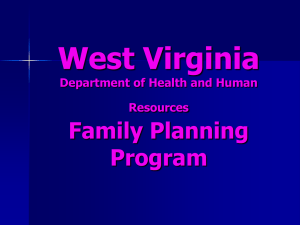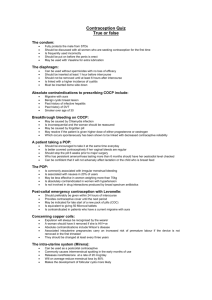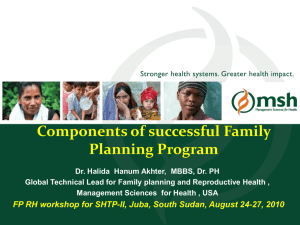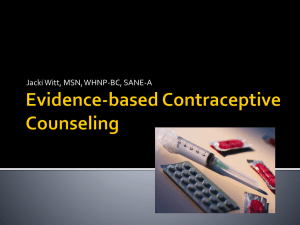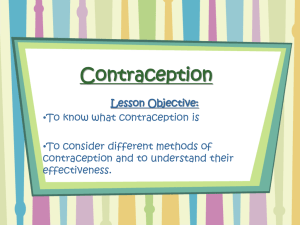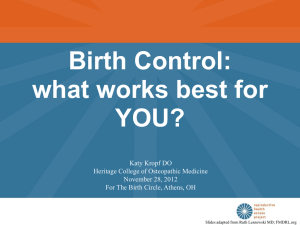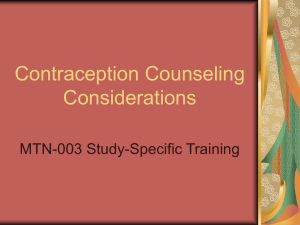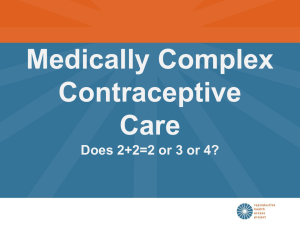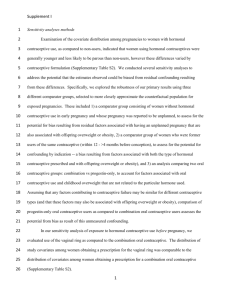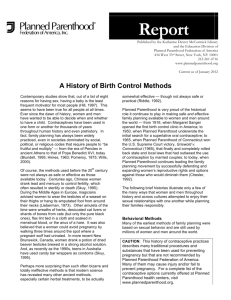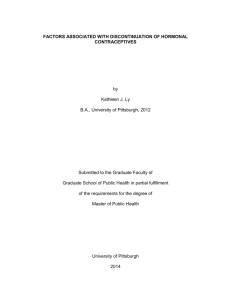15: Contraception Counseling
advertisement
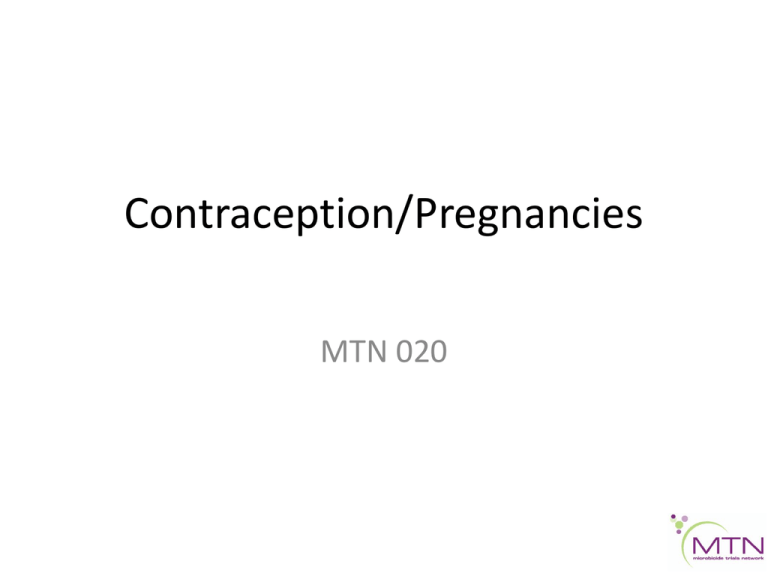
Contraception/Pregnancies MTN 020 Why do we care? • Participants must come off product during pregnancy and breastfeeding – Studies of dapivirine in pregnant animals suggest no harm – BUT, dapivirine has not been testing in human pregnancy • Time off product results in dilution of effect – If there really is a protective effect of study product, we may not be able to detect it because of time off product ASPIRE Goal- Pregnancy Prevention • Prevent intentional pregnancies – Screening procedures • Prevent unintentional pregnancies – Offer contraceptive counseling – Providing effective contraception – Expand the contraceptive mix available to participants in ASPIRE Contraceptive Counseling • Open conversations • Participant centered • Goal – Provide rationale for contraceptive requirement • dapivirine is an investigational product – Counsel on all available methods – Help ppt to choose the method that is best for her – Obtain accurate information about use Expanding Methods Mix Background and References WHO Medical Eligibility Criteria for Contraceptive Use (with 2008 update) Your contraceptive site experts Princess Nonzwakazi Family Planning: Aand Global Handbook for Providers (USAID/JHSPH/WHO) Trisha and Clearance Thembekile Contraceptive Technology, 20th Edition Screening • Protocol Section 5.2 • Not pregnant • Using an effective method of contraception at enrollment – Hormonal method (except ring) – IUCD – Sterilization of participant (not partner) • Intending to use an effective method for the duration of study participation Case 1 • 19 yo woman is interested in participating in MTN 020. She is sexually active with one stable male partner for the past six months. • She agrees to use some form of contraception • She currently uses male condoms “some of the time” Case 1 • Describe how you would counsel her. • Any concerns about starting BOTH a new method of contraception AND dapivirine ring? (side effects, adherence/joint adherence, etc.) Choosing a Contraception • Did you know? – IUCD is a good option- even for women who have never had a baby? – OCP use is associated with the highest pregnancy rate of MTN 020 methods? – In some studies, DMPA is associated with a higher rate of HIV acquisition? Ask your contraceptive expert for more information Enrollment • Tracking contraceptive method is imperative – It starts at enrollment- Baseline Family Planning • Identifying baseline side effects is important – Baseline = enrollment visit – May impact contraception adherence – May impact product use adherence – May impact AE reporting in the future Case 2 • The same participant from Case 1 has opted for DMPA • She receives her first injection at screening • When she returns for her enrollment visit she reports intermittent spotting since her injection 3 weeks ago – – – – Assess willingness to continue method Address concerns; provide reassurance if applicable Anticipate problems Review options Case 2 • What forms do you need to complete? – PRE-1 – Update Menstrual History – Baseline Family Planning • Does this situation concern you? Follow-Up • Tracking contraception use at every visit – Family Planning CRF • Contraceptive Counseling at every visit – Contraceptive work sheet template • Record sufficient information to review and follow-up at each visit • For methods dispensed at site, chart flags are recommended Case 3 • A 23 year old woman presents for her Month 3 visit and tells you that she was married two weeks ago • She started oral contraceptive pills at the screening visit • The site receptionist overheard the participant telling another participant that she was looking forward to the pregnancy test because she and her new husband were hopeful for a child soon • How will you elicit truthful information from this participant? – What are your concerns? – How will you start this conversation? Case 3 • In fact, she has not been taking her oral contraceptive pills • What now? – Counseling messages – Study product implications – Study participation implications – Documentation Pregnancy • Protocol Section 7.5.2 – Continue all protocol specified procedures except • Provision of vaginal ring • Product use instructions • Adherence counseling* – Retention check-in will continue with pregnancy (Step 6 of ACE Program) • Pelvic exams, including vaginal fluid collection, after 24 weeks – Both pelvic and self swab collection are optional after 24 weeks. They are safe and should be encouraged. • Contraceptive counseling – Offer enrollment into MTN 016 Case 4 • 27 year old woman on oral contraceptive pills presents for her month 6 visit with some nausea/vomiting x 2 weeks – Urine pregnancy test is positive • What will you do and how will you document? – – – – – Monthly Lab Results CRF Pregnancy Report CRF Conmed CRF (contraception stopped) Product hold CRF Vaginal Ring Request Slip Case 4 • She presents 2 weeks later for an interim visit with scant vaginal bleeding and cramping • Has an AE occurred? – SSP Section 11.3.3 • She returns two weeks later and reports that she had a miscarriage soon after leaving the clinic last visit Case 4 • Next steps? – Confirm status of pregnancy versus loss – Complete pregnancy outcomes form • When can product be resumed? – – – – Protocol Section 7.5.2 Negative pregnancy test Not breastfeeding Absence of findings on pelvic exam that would contraindicate resumption Big Picture • Time off product limits our ability to detect the ring’s protective effect, if it exists • Minimize intended pregnancies by careful screening procedures • Minimize unintended pregnancies by providing relevant counseling and appropriate methods Big Picture (2) • Maximize product adherence by addressing side effects of both contraceptive method and study product • Elicit truthful contraceptive use • When in doubt, ask your experts…..
